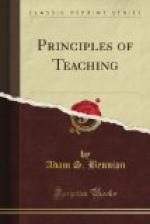Occasionally a teacher objects to outlining on the ground that it is too mechanical—that it destroys spontaneity and the flow of the Spirit of the Lord. It has always seemed to the writer that the Spirit of the Lord is quite as pleased to follow a straight path as it is to follow a crooked one. Outlining is not in any sense a substitute for inspiration—it is merely a guarantee, by way of preparation, that the teacher has done his part and can in good conscience ask for that spiritual aid and guidance which he then is entitled to. The fact that order is a law of heaven rather indicates that there is no divine injunction against outlining.
Of course, outlining is not an end in itself—it is a means merely to more systematic procedure. Two difficulties frequently attach to outlining: one is that the outline is made so complex that it hinders rather than helps in the matter of clearness; the other is that a teacher may become “outline bound,” in which case his teaching becomes mechanical and labored. Such a teacher illustrates clearly the force of the passage, “The letter killeth, but the spirit giveth life.”
But if the outline is made simple—if it is considered as merely a skeleton upon which is to be built the lesson—it is one of the greatest assets a teacher can have. Perhaps we can make the matter clearest by going through the process of outlining a lesson, indicating the essential steps involved.
Suppose we are asked to prepare a lesson on prayer. Keep in mind that in such a preparation we face the problems listed at the beginning of this chapter: the aim, the illustration, the application, etc., and keep in mind also that each of these subjects will be taken up in its turn and that for the present we are concerned primarily with the query, “How can I organize a lesson on prayer?” Let us assume, too, that we are preparing this lesson for young men and women about twenty years of age.
First of all, I must decide why I am to teach the subject of prayer. In view of the fact that the matter of the aim is to be considered fully in the succeeding chapter, suppose we agree that our purpose in this lesson shall be to establish prayer as a habit of life.
Step number one, then, is the selection of an aim—a focus for the thought of the lesson.
Step number two is the collection of random thoughts. As I begin to ponder the subject of prayer and its influence on life, all sorts of ideas crowd into my mind. Perhaps I read some one’s discussion of prayer—perhaps I talk to a friend relative to it—perhaps I just ran the subject over in my mind. The thoughts that come to me may be vague and wholly disconnected. My immediate concern is content—order will come later. And so I jot down, either in my mind or on paper, such ideas as these:




